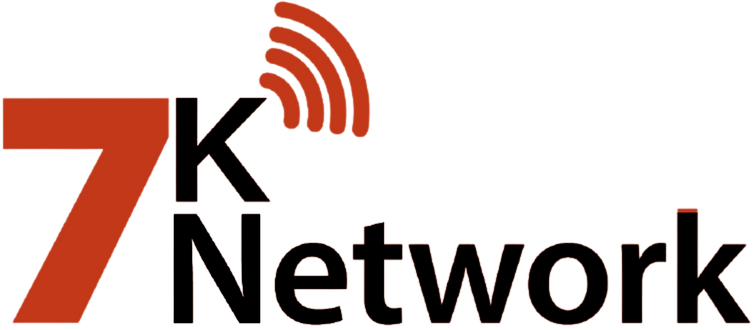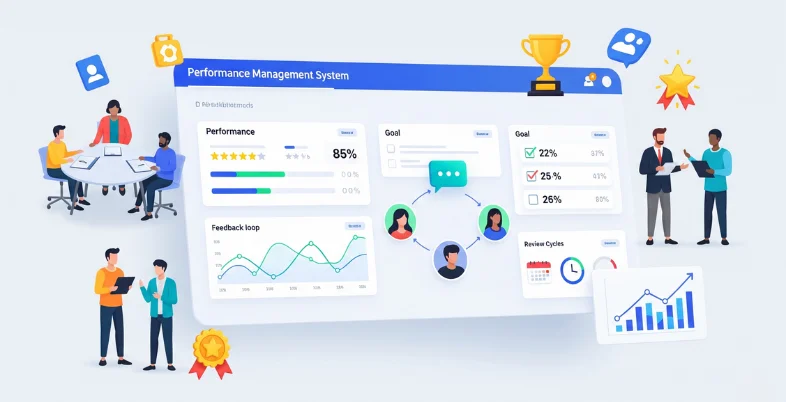Modern organisations are not merely tracking employee outputs, they are influencing performance with the help of structured coaching, alignment of goals, feedback, and analytics. Conventional annual appraisals are not adequate anymore. Rather, the current generation performance management is based on constant dialogue, moment to moment insights, and growth-based structures. With the right system this transformation can be made manageable, scalable and effective for large and small teams, across all fields.
In this comprehensive guide, we profile top leading performance management systems, from goal-setting tools and continuous feedback systems to enterprise-grade review engines. Discover what each offers, how they support modern needs like OKRs, AI-assisted reviews, and engagement tracking, and how to choose the best fit for your organization.
Why Performance Management Software Matters
Effective performance management systems offer more than reviews, they enable strategic alignment, boost motivation, and provide foresight into potential disengagement. These platforms support:
- Continuous feedback & check-ins, replacing annual appraisal cycles
- Goal and OKR tracking, aligning individual contributions with business outcomes
- 360-degree inputs, ensuring diverse perspectives in evaluations
- Automated reminders and workflows, reducing administrative burden
- Analytics dashboards, turning performance data into actionable insights
List of Top 15 Performance Management Systems
1. Lattice
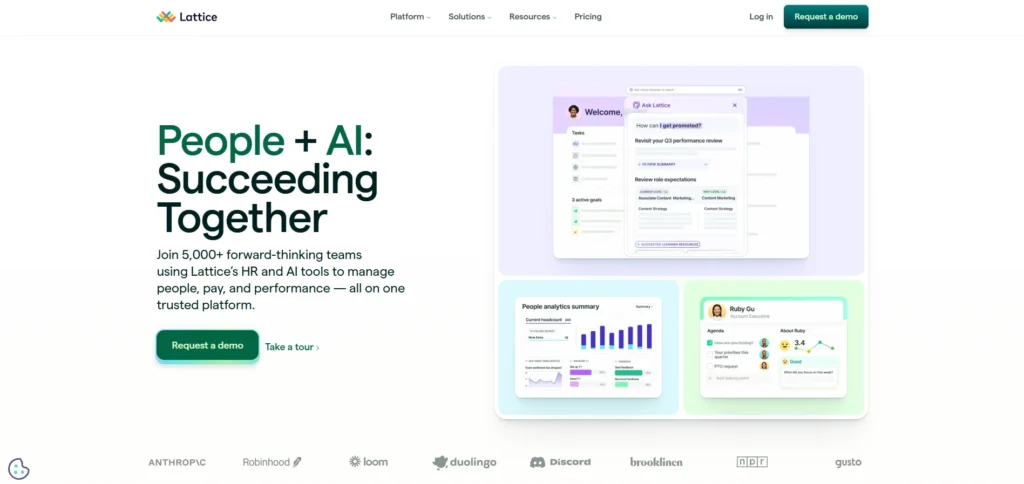
Website: https://www.lattice.com
Lattice offers a complete performance management suite with powerful goal-setting, feedback, and review workflows. As one of the leading workflow management platforms, it features customizable templates, continuous check-ins, 360 feedback, and one-on-one meeting tools to support structured development. Lattice integrates with HR systems and collaboration tools like Slack and Outlook for seamless workflows.
Managers can track performance trends and engagement across teams while supporting promotions and coaching paths. Reporting dashboards clearly highlight top performers, feedback frequency, and goal progress. Many HR leaders use Lattice to foster a culture of continuous growth and performance transparency.
Key Features:
- Peer-to-peer recognition and feedback
- Automated milestone celebrations and reminder workflows
- Integrations (Slack, MS Teams, HRIS systems)
- Customizable goal setting & review cycles
- Engagement analytics and trend reporting
Pricing:
- Grow – $3/user/month
- Performance & Engagement – $9/user/month
- Enterprise packages – custom pricing
2. BambooHR (Performance Module)
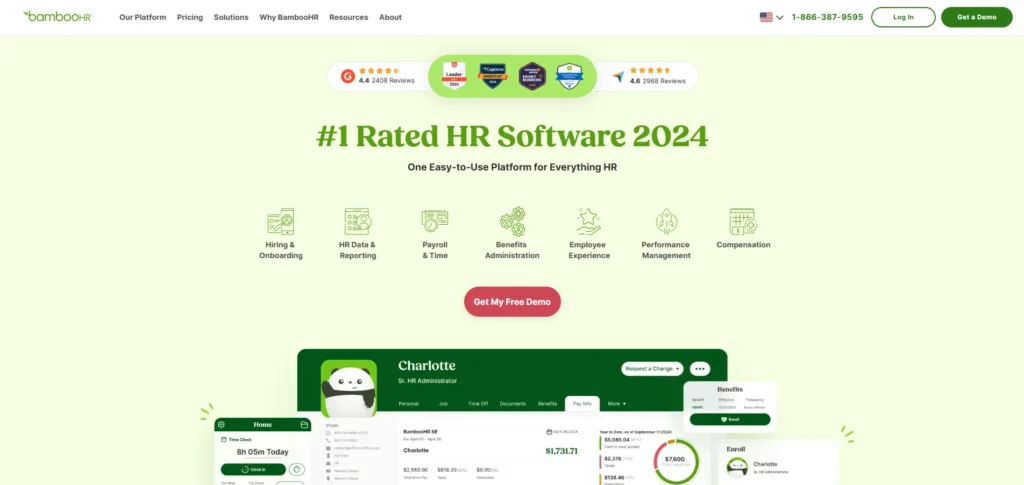
Website: https://www.bamboohr.com
BambooHR is primarily an HRIS, but its performance module provides core tools like goal tracking, self- and manager reviews, and basic feedback processes. Its intuitive user interface is good for small to mid-sized teams that want one platform to handle employee data and review cycles. As an employee management software, it allows managers to use customizable review templates and schedule appraisal events.
Performance data integrates across modules, giving snapshot reports of engagement and review completion. BambooHR’s strength lies in combining recruitment, onboarding, engagement, and performance in a single system. HR teams looking for a unified, user-friendly HR software will find it particularly appealing.
Key Features:
- Peer and manager feedback / recognition
- Automated reminders for reviews and milestones
- Integrations with HRIS and payroll systems
- Review templates and goal tracking
- Engagement and completion analytics
Pricing:
- About $6–8/user/month depending on modules
3. Workday (Performance Management)
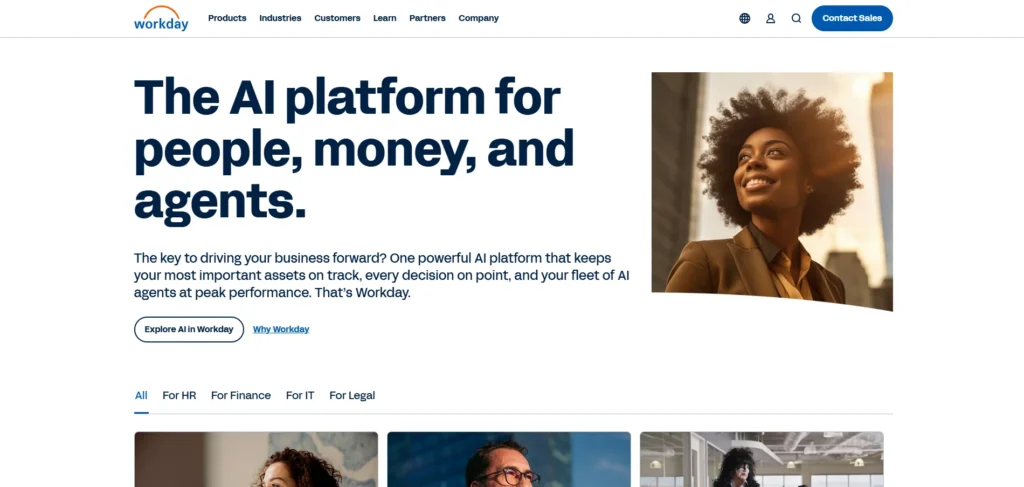
Website: https://www.workday.com
Workday is a full enterprise HR management software suite that includes both human resources and financial management capabilities, with a robust performance management module built in. It supports goal alignment, continuous feedback, calibration, and succession planning. Deep analytics and integration with learning, payroll, and talent modules make Workday ideal for large organizations managing complexity.
Workday excels in supporting global employee populations with multilingual support and consolidated performance reporting. Its review engine can handle multiple cycles self, peer, and manager, with customizable approvals. The system connects performance with compensation and career mobility, giving organizations strategic control.
Key Features:
- Peer-to-peer recognition and feedback
- Automated milestone and review workflows
- Integrations (HRIS, payroll, collaboration tools)
- Scalable goal and review engine
- Advanced performance analytics
Pricing:
- Custom enterprise pricing based on modules and users
4. 15Five
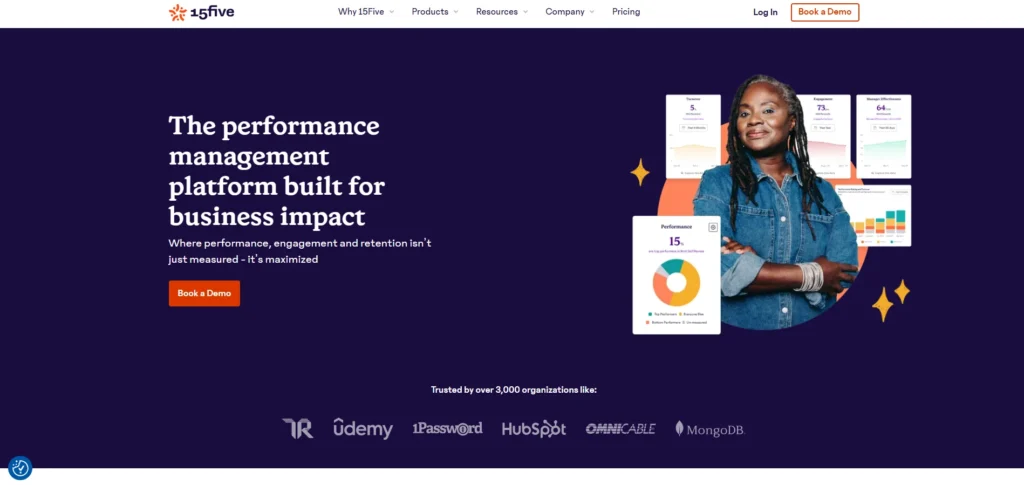
Website: https://www.15five.com
15Five is designed around continuous check-ins, self-assessments, and informal feedback. Every week employees can share wins and challenges, which managers view to inform personalized development. Formal review cycles, goal/OKR management, and social feed-based recognition are further features of the platform. With 360-degree feedback and crowd-sourced reviews, it combines performance and culture building.
The intuitive user experience supports agile teams that want lightweight yet structured performance tracking. 15Five is often adopted by startups and growth companies looking to build coaching-oriented practices.
Key Features:
- Peer-to-peer recognition and social shout-outs
- Automated reminders for check-ins and reviews
- Integrations (HR systems, Slack, Teams)
- Goal and OKR tracking
- Engagement and review analytics
Pricing:
- Custom quote depending on features and size
5. PerformYard Talent
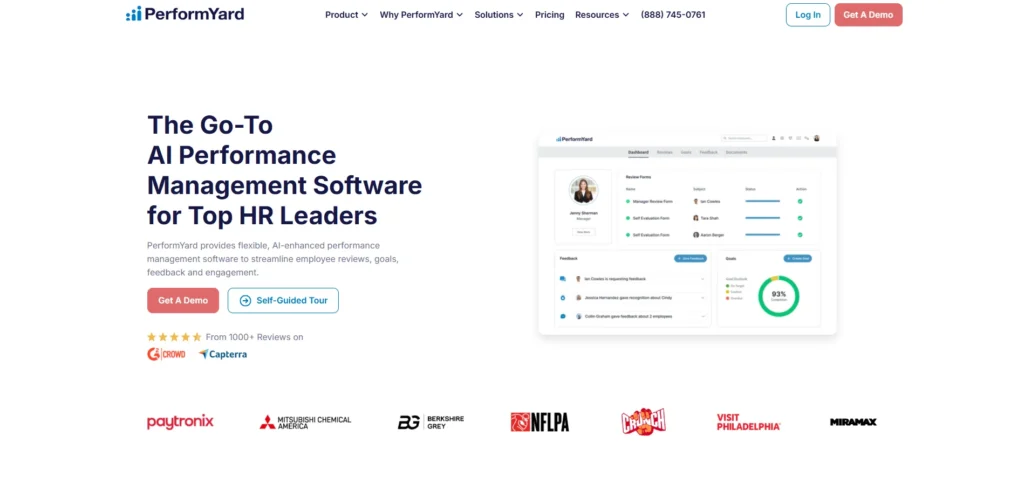
Website: https://www.performyard.com
PerformYard offers flexible workflows for performance reviews, goal management, and continuous feedback. It allows HR teams to build custom cycles, for example quarterly reviews or seasonal appraisals, with automated notifications. The platform supports upward, peer, and manager review types with customizable reviewers and questions. Dashboards visualize who has completed reviews, goal progress, and feedback frequency.
Integration with popular HRIS tools ensures data alignment across systems. PerformYard is well-suited for organizations that need configurable, process-heavy evaluation frameworks.
Key Features:
- Peer-to-peer feedback and recognition
- Automated review and milestone workflows
- Integrations (ADP, BambooHR, Workday)
- Custom goals and review structures
- Analytics on completion rates and trends
Pricing:
- $5–10/user/month depending on volume
6. Leapsome
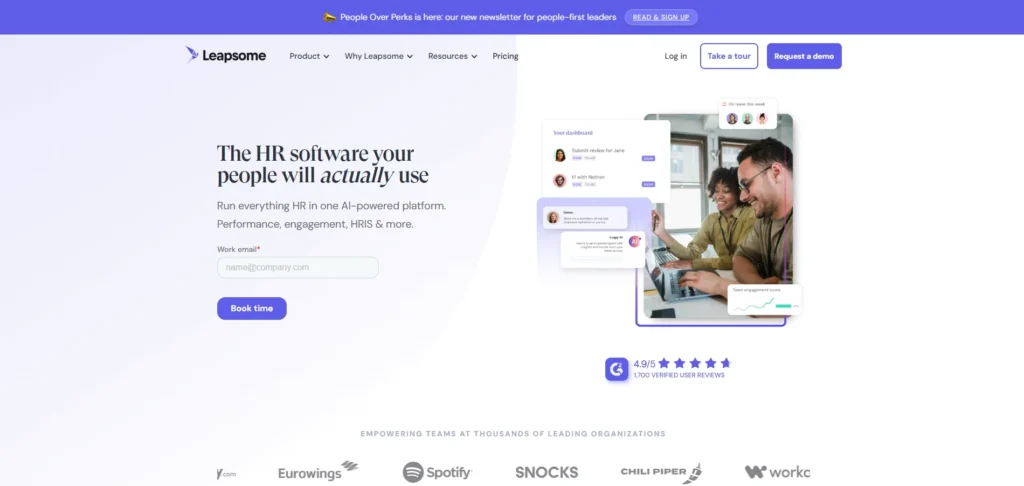
Website: https://www.leapsome.com
Leapsome blends performance reviews, 360 feedback, goal/OKR tracking, and learning & development into one platform. It offers competency frameworks for evaluation and personal development plans. Built-in learning modules let organizations support growth through targeted training. Review cycles, pulse surveys, and development path-aligned goals can all be conducted by users.
Reporting dashboards, including integration capabilities with Power BI dashboards, help leaders spot performance gaps and adjust L&D plans accordingly. Used by fast-growth and enterprise organizations, Leapsome supports both structured reviews and continuous feedback.
Key Features:
- Peer-to-peer recognition and feedback
- Automated milestone celebrations and review triggers
- Integrations (HRIS, Slack, Teams)
- OKR, goal tracking, and L&D modules
- In-depth analytics on performance and engagement
Pricing:
- Around $8/user/month for full suite
7. ClearCompany
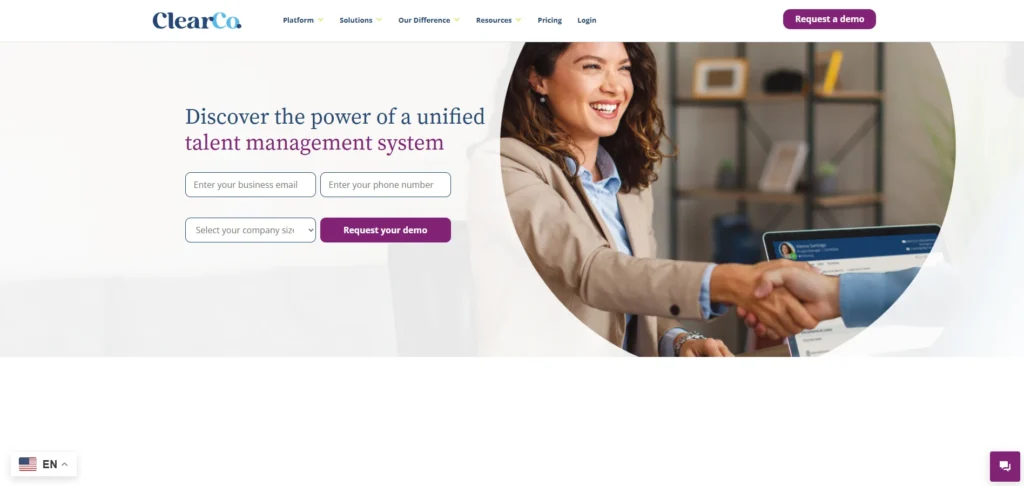
Website: https://www.clearcompany.com
ClearCompany is a talent platform offering performance reviews, 360 feedback, goal alignment, and succession planning. With dashboards tied to employee competencies, managers can evaluate both skills and outcomes. The platform also manages performance improvement plans and calibration workflows.
ClearCompany integrates with ATS tools and HRIS systems, providing a full HR ecosystem. Organizations can align review cycles with internal hiring, retention strategies, and promotion pipelines. This system suits HR teams that want performance management tightly linked to broader talent initiatives.
Key Features:
- Peer and manager recognition and feedback
- Automated review and milestone processes
- Integrations (HRIS, ATS, collaboration tools)
- Goal alignment and competency tracking
- Analytics on retention, performance, and succession planning
Pricing:
- Custom pricing based on suite modules
8. Reflektive
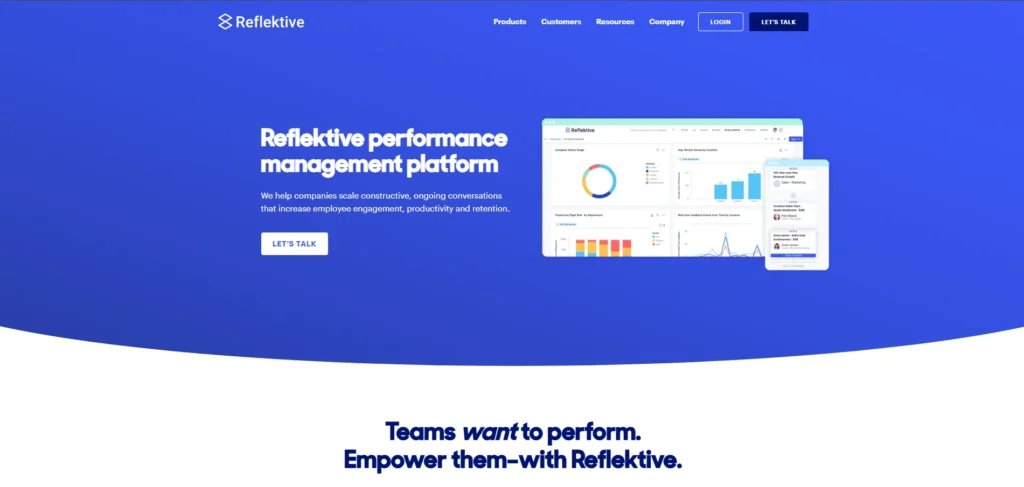
Website: https://www.reflektive.com
Reflektive focuses on real-time feedback, performance calibration, and agile goal tracking. Users can leave instant comments and affirmations, complementing formal review cycles. The platform includes pulse surveys and analytics to help managers stay connected to team sentiment. Goals are transparent and can be tracked collaboratively. Reflektive integrates with communication tools to keep feedback visible. Overall, it’s well-suited for companies embracing continuous performance conversations and social recognition.
Key Features:
- Peer-to-peer recognition and feedback
- Automated meeting and review reminders
- Integrations (Slack, HR tools)
- Collaborative goals tracking
- Feedback and sentiment analytics
Pricing:
- Custom pricing
9. Betterworks
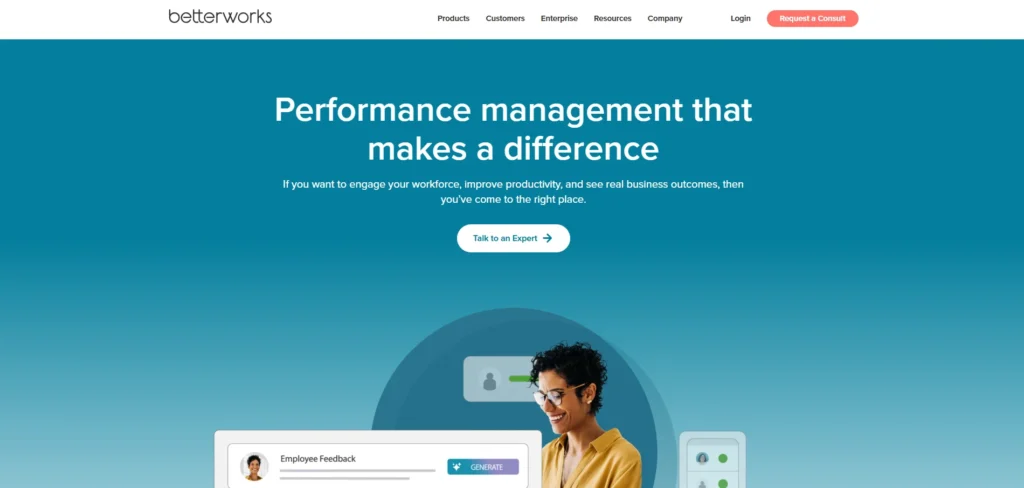
Website: https://www.betterworks.com
Betterworks is tailored around the OKR framework with features promoting goal visibility, progress tracking, and continuous feedback. It helps align team and individual goals to business outcomes with dashboards showing real-time progress. Users can request feedback and conduct one-on-one sessions within the platform. Performance reviews and pulse checks complement the goal structures. Management dashboards give leadership clear visibility into performance gaps and outcome-focused results.
Key Features:
- Peer and manager recognition and feedback
- Automated goal and review workflows
- Integrations with HRIS and collaboration tools
- OKR and goal tracking
- Analytics on performance outcomes and alignment
Pricing:
- Custom pricing
10. 7Geese
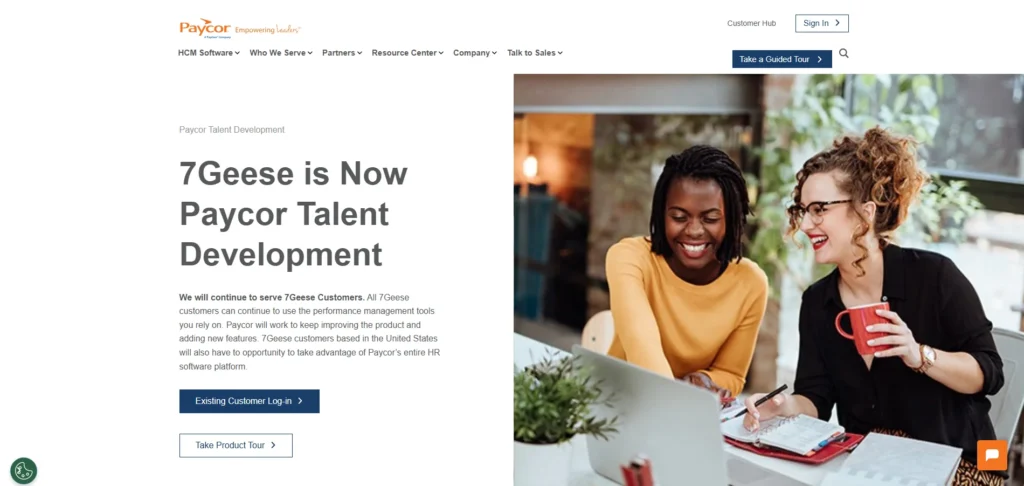
Website: https://www.7geese.com
7Geese (now part of Paycor) is an OKR-driven platform that supports goal setting, feedback, reviews, and continuous coaching. Users can align individual objectives with company-level goals and track progress visually. It includes templates for one-on‑one meetings and recognition workflows. Managers use dashboards to monitor engagement and performance trends. Ideal for mid-sized companies using OKRs as a management philosophy, 7Geese encourages transparency and alignment across teams.
Key Features:
- Peer and manager recognition and feedback
- Automated milestone celebrations and reminders
- Integrations (Slack, HRIS, Paycor)
- OKR-based goal tracking
- Analytics on alignment and engagement
Pricing:
- Custom pricing
11. Culture Amp
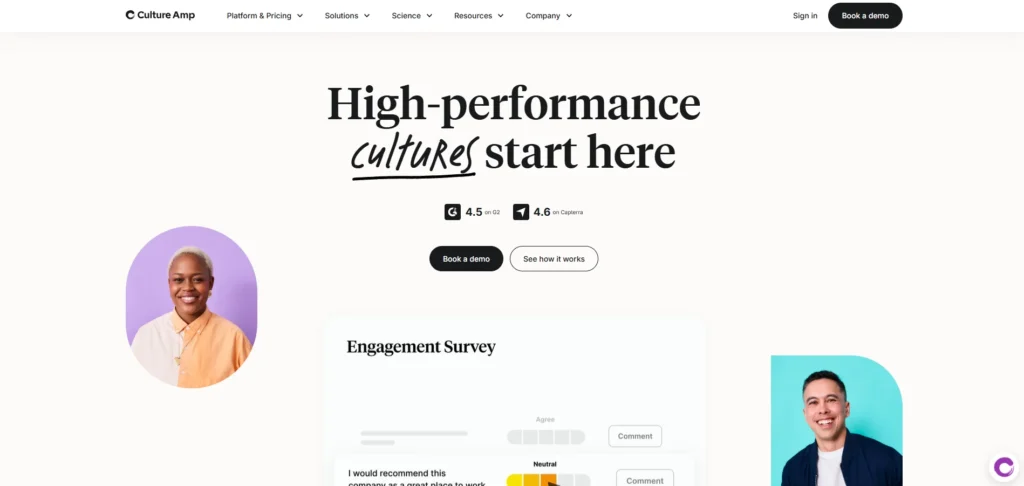
Website: https://www.cultureamp.com
Culture Amp is a system that integrates performance evaluations, feedback mechanisms, and engagement surveys. It’s data-driven and excels at measuring sentiment and aligning performance outcomes with employee satisfaction. Managers can blend review cycles with pulse check-ins and learning modules. Reporting includes engagement trends correlated with review outcomes and demographic data. Organizations use Culture Amp when employee experience and performance are both central to HR strategy.
Key Features:
- Peer and manager feedback and recognition
- Automated review scheduling and milestone tracking
- Integrations (Slack, HRIS, survey tools)
- Review forms linked to development goals
- Deep analytics on engagement and performance
Pricing:
- Custom pricing
12. Engagedly
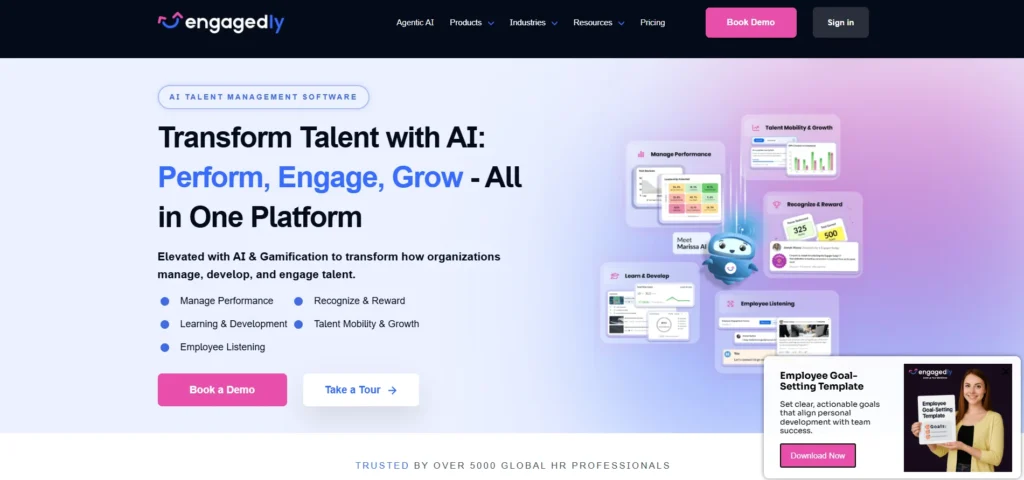
Website: https://www.engagedly.com
Engagedly is a gamified performance and engagement platform that includes continuous feedback, performance reviews, goal setting, and learning paths. It encourages peer acknowledgment through social praise, badges, and awards. Competency frameworks and succession planning tools support leadership pipelines. Pulse surveys help track morale, and dashboards track performance trends and development progress. Engagedly supports both review cycles and culture-building initiatives.
Key Features:
- Peer recognition and manager feedback
- Automated milestone and review workflows
- Integrations (HRIS, collaboration tools)
- Goal tracking and competency management
- Engagement and recognition analytics
Pricing:
- Custom enterprise pricing
13. GroSum
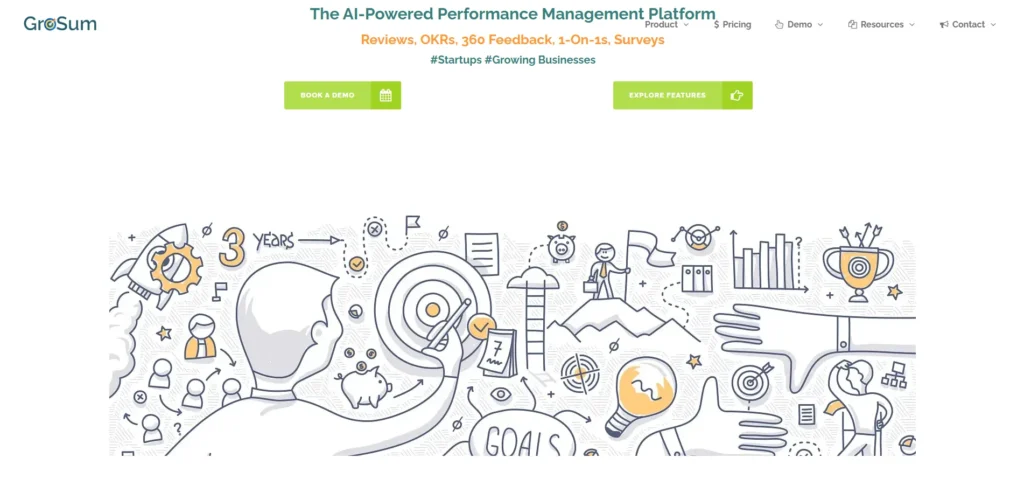
Website: https://www.grosum.com
GroSum is a cloud-based performance management software that offers performance reviews, 360 feedback, goal setting, scoring, and analytics. Key strengths include flexible performance workflows and automated alerts for review cycles. It supports continuous check-ins and peer praise. Real-time dashboards help managers notice completion rates and feedback quality. Offers are compatible across desktop and mobile platforms, and support is provided via email and phone. GroSum is often chosen by SMBs looking for an affordable all-in-one performance tool.
Key Features:
- Peer and manager feedback
- Automated reviews and milestone reminders
- Integrations (limited HRIS but supports email alerts)
- Goal setting and scoring workflows
- Real-time performance analytics
Pricing:
- Performance Review plan: ~$100/month for 50 users
- Feedback & OKR plan: ~$500/month for 25 users
- 360 Feedback plan: ~$1,000/month for 30 users.
14. Impraise
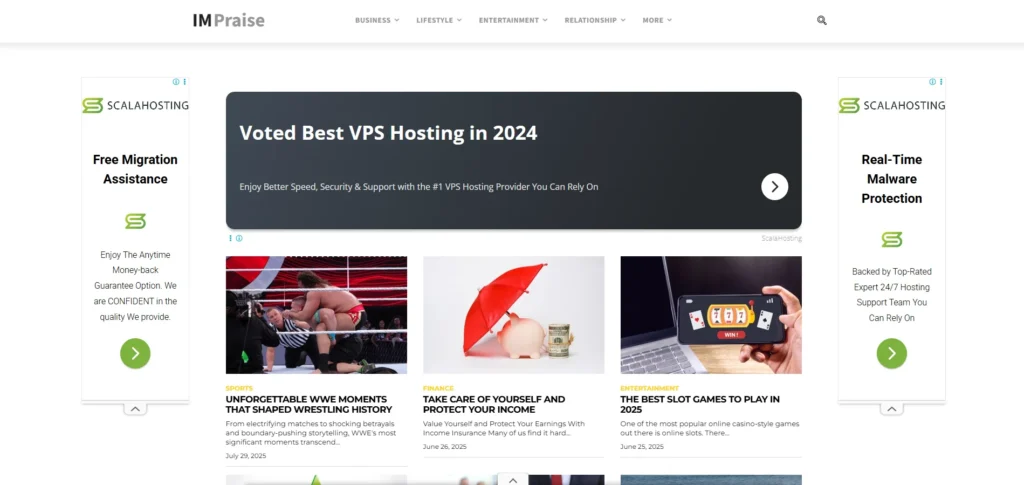
Website: https://www.impraise.com
Impraise provides real-time feedback, check-ins, goal management, and performance reviews in one interface. The tool supports conversational feedback, 1:1 agendas, and peer review campaigns. Integration with collaboration tools keeps feedback where people work. Managers can track personal development and monitor team engagement. Performance rating and review cycles are customizable while analytics highlight high and low performers. Impraise balances development-focused coaching with structured evaluations.
Key Features:
- Peer and manager feedback pipelines
- Automated review triggers and reminders
- Integrations (Slack, HR systems)
- Goals, OKRs, and review frameworks
- Feedback and review analytics
Pricing:
- Custom pricing
15. Workleap Officevibe
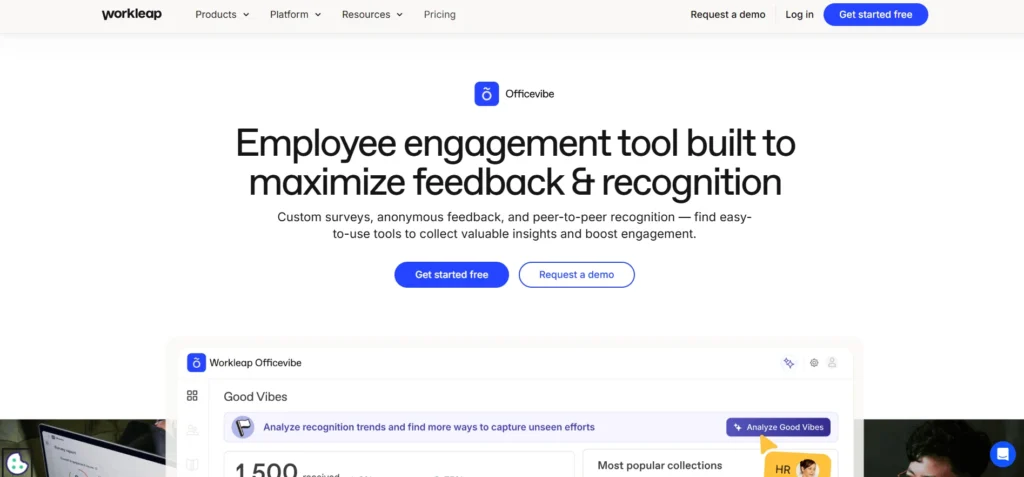
Website: https://www.officevibe.com
Officevibe emphasizes continuous feedback and pulse surveys, including anonymous feedback tools. The platform also includes peer recognition and goal tracking features suitable for modern teams. Its “Good Vibes” function enables public praise among colleagues. Regular interaction is ensured by automated performance check-ins and review scheduling. HR teams gain access to engagement analytics, team sentiment dashboards, and performance review completion stats. Best for mid-size teams seeking lightweight, feedback-oriented performance tools.
Key Features:
- Peer-to-peer recognition and feedback
- Automated reminders for reviews and surveys
- Integrations (Slack, email, HR systems)
- Goal tracking and survey workflows
- Engagement and sentiment analytics
Pricing:
- Plans start around $5/user/month
- Free trials available
Benefits of Using Performance Management Software
- Supports continuous feedback and coaching through real-time tools and check-in automation
- Aligns individual performance with goals and OKRs, improving strategic visibility
- Increases fairness and inclusivity by using tools like AI for bias reduction in reviews.
- Offers deep insights through analytics, enabling identification of performance trends and high-performers
- Reduces administrative burdens by automating reminders, workflows, and review scheduling
- Improves retention and engagement, as documented performance management is linked with higher satisfaction
How to Choose the Right System
When evaluating performance management software, keep these key considerations in mind:
Team Size and Complexity:
- Small to mid-sized businesses often prefer simpler tools like BambooHR or GroSum
- Enterprises require advanced systems like Workday or Culture Amp to handle large-scale needs
Review Cadence:
- Choose a platform that supports your preferred performance cycle, be it continuous, quarterly, or annual
Feedback Types Supported:
- Ensure the system enables 360-degree feedback, manager evaluations, and peer-to-peer reviews for comprehensive insights
Goal-Setting Framework Compatibility:
- Select software that aligns with your organization’s method, such as OKRs, KPIs, or competency-based goals
Integration With Existing Tools:
- Check for smooth integration with platforms such as payroll, Microsoft Teams, Slack, HRIS, and ATS.
Analytics and Reporting Depth:
- The platform should offer detailed dashboards, trend analysis, and performance tracking for actionable insights
Mobile Accessibility:
- Ensure the tool provides a robust mobile app or responsive interface to support remote and distributed teams
Conclusion
Performance management systems are no longer optional, they’re essential for any organization seeking to foster agile, engaged, and goal-aligned teams. The days of annual reviews are over; modern platforms enable ongoing feedback, goal alignment, and data-driven insights that inform both individual growth and organizational decisions.
Among these platforms profiled, ranging from lightweight tools like Officevibe and GroSum to enterprise-grade solutions like Workday, Culture Amp, and Leapsome, you’ll find options suited for every team size and maturity level. Choose based on your cadence, feedback style, integration needs, and culture goals, and you’ll be equipping your people and leaders to perform at their best.
FAQs
1. What’s the Difference Between Continuous Feedback Systems and Traditional Reviews?
Continuous feedback tools support weekly or monthly check-ins and goals tracking, whereas traditional reviews happen annually or semi-annually.
2. Are OKRs Supported by Most Systems?
Yes, platforms like Betterworks, Leapsome, 7Geese, and Lattice offer robust OKR frameworks.
3. Can Smaller Teams Benefit from these Platforms?
Absolutely. Tools like BambooHR, 15Five, Impraise, and Officevibe are great for startups and SMBs.
4. Is 360-Degree Feedback Necessary?
While not always required, 360 feedback offers a richer, more balanced performance perspective and is supported by Lattice, Reflektive, PerformYard, and others.
5. How Do AI and Analytics Impact Performance Reviews?
AI can reduce biases, assist with phrasing, and improve fairness, while analytics help HR spot trends, gaps, and talent risks across the organization.
